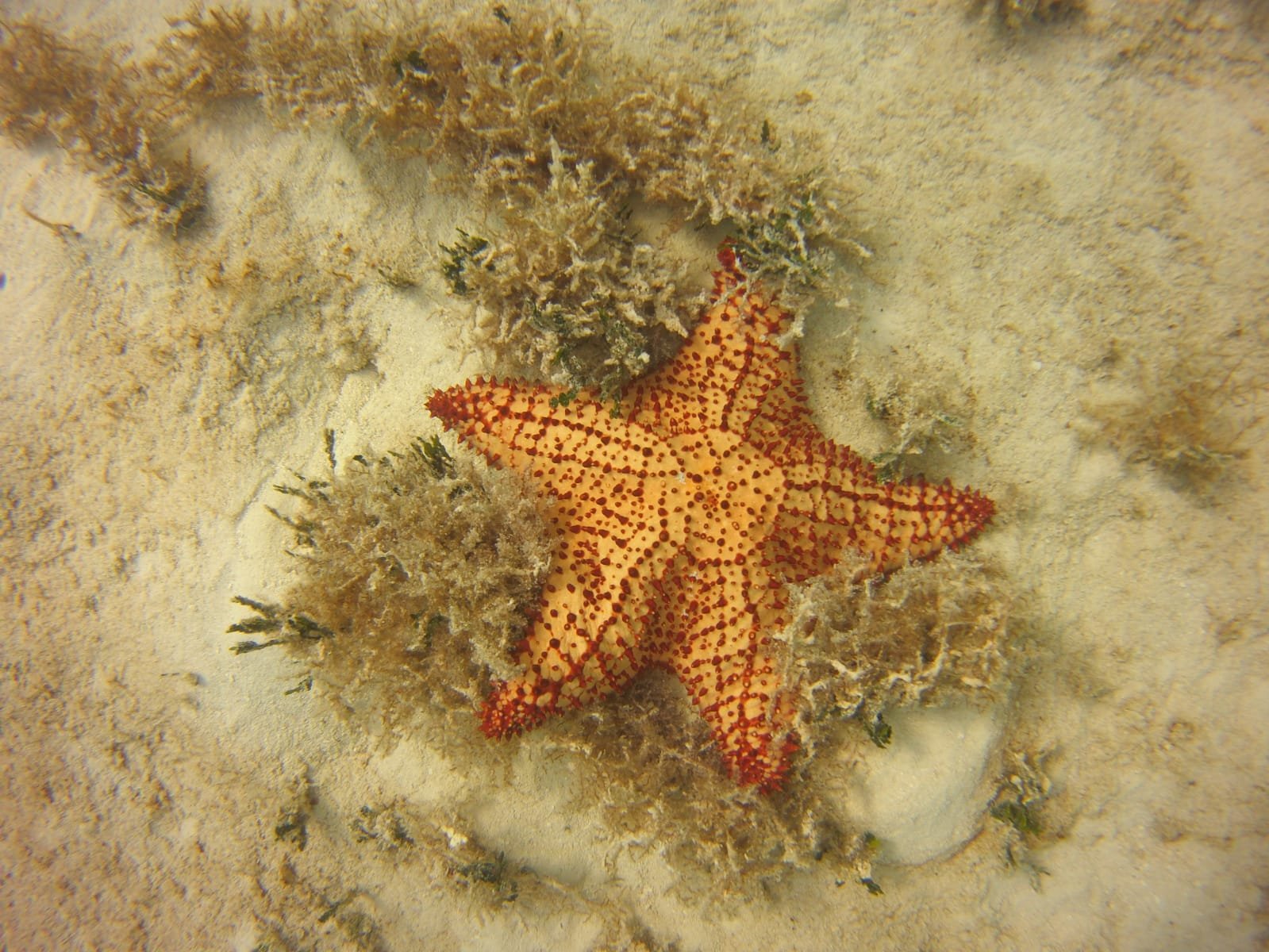Marine Conservation - Live From Mexico - Part 4
By Rose Little - Wildlife & Welfare Researcher volunteering with Global Vision International (GVI) in Puerto Morelos, Mexico
Me and my hopes for Marine Conservation
Rose working with elephants in Thailand
I have always had a keen interest in science and conservation and when I left school I wanted to experience as much of the world as I could in the most sustainable way. However, I wanted to find a way to negate the huge carbon footprint I would create flying to different countries. I decided that joining conservation projects would be a great start towards this goal and would mean I could start giving back to environments humans have exploited. I first joined GVI in 2016 in Thailand volunteering on an elephant reintroduction project. Since then, I have wanted to experience more conservation work, giving back to communities and the environment. During my university degree (Animal Science BSc at Reading University) I had the opportunity to undertake an industrial placement year. I decided to spend half of the year with GVI and learn more about marine conservation. This was a field that I knew was important however I had never researched or particularly thought I should get involved with. Growing up in a landlocked area of the UK I never particularly thought more of the ocean than a fun and distant holiday destination. However, joining GVI in Puerto Morelos was one of the best decisions of my life. It is where I began my journey into marine conservation and developed my passion for marine life. There is so much life in the ocean and the ocean is vital for the existence of all terrestrial organisms too.
The ocean covers 70% of the earth's surface and with only 5% of the marine world explored its conservation is paramount.
It is terrifying how impactful humanity has been in this tiny portion of the ocean. A recent study has revealed that a plastic grocery bag is the deepest known piece of plastic found at 10,975 meters below sea level inside the Mariana Trench. Alongside this there are plastic islands in our gyre systems which contain millions of microplastics. To find out more about plastic in the oceans read my second blog in this series (Ocean Waste and Beach Cleans). Discovering these very human impacts on our ocean has inspired me to continue learning and educating people around me to reduce their plastic usage and to pick up any rubbish we see. If we all pick up 3 pieces of plastic each time we left our homes the world would be a much cleaner and healthier place. If we can inspire one person to change their plastic habits, we are creating a chain reaction to fight the plastic industry and plastic pollution in the environment.
Plastic pollution in the environment is only one problem. We need to reduce and recycle our plastics because new plastics are made from coal, natural gas and crude oils through polymerisation and polycondensation processes. To make 1kg of plastic releases 1kg of carbon dioxide into our atmosphere. Since the industrial revolution beginning in 1790 the concentration of carbon dioxide in the atmosphere has increased significantly due to the changes in land use and the burning of fossil fuels. It is my hope that the UK and other countries follow policies to eliminate the use of fossil fuels to heat our homes and offices. The UK, Mexico and 173 other countries have signed the Paris Agreement which aims to limit global warming to below 1.5 degrees Celsius, compared to pre-industrial levels. This agreement allows countries to work together to reach zero carbon solutions for the most polluting industries however the last five years have been the hottest on record since the industrial revolution. As Greta Thunberg said in her response to 5 years on from the Paris Agreement:
We have to start treating climate change as an emergency and make substantial changes now or we will not be able to meet our 2030 or 2050 climate targets.
The ocean absorbs 30% of the carbon dioxide released into the atmosphere. As the atmospheric carbon dioxide levels increase, so do the levels in the ocean. This is devastating for marine life. As carbon dioxide is absorbed into the ocean the acidity of the ocean increases. This in turn decreases the abundance of carbonate ions. Carbonate ions are essential for the construction of seashells and coral skeletons and so a lack of these makes it difficult to maintain and build shells and calcium carbonate structures for calcifying organisms such as sea urchins, oysters, muscles, shallow and deep water corals and calcareous plankton. Ocean acidification is affecting the entire marine ecosystem on which many economies rely.
My position as a scholar within GVI and as a researcher for Wildlife and Welfare gives me the opportunity to educate people in marine conservation. It is my belief that marine conservation is paramount to the survival of the planet as the ocean is our carbon and heat sink, the coral reefs and mangroves protect our coastlines from erosion, and they limit the occurrences of natural disasters. In 2004, the United Nations Convention on Biological Diversity (CBD) set a target to protect 10% of marine environment. We are nowhere close to this target in 2021 with only 5% of the ocean currently protected through Marine Protected Areas (MPAs). It is my hope that with more research and more people involved in marine conservation we will meet the CBD target and more.
Spotted Eagle Ray
Seastar
Porites astreoides - (mustard hill coral)
Here at GVI I partake in weekly beach cleans and collect data on the marine ecosystem to assist companies and charities affecting the decisions of policy makers. Being a part of data collection is an amazing experience and it is vital for everyone who can, to get involved. The more data collected on marine health and its decline, the easier it is to persuade policy makers to make regulations and protected areas to support marine conservation. I can also inspire other people and divers to respect the marine environment and make them want to protect it too. As a PADI Divemaster I show other divers the amazing beauty of the reef, pointing out the more unique creatures and most importantly showing them how to respect the ocean and the ocean’s creatures. By diving conscientiously, maintaining good buoyancy and wearing barriers instead of sunscreen we can protect the reef from damage from divers. Every diver has a particular responsibility to protect the ocean from damage as we are guests in the ocean. We should not be there and so we should not have negative effects on the ecosystem.
GVI is also a good platform to learn many research techniques and gain connections which would assist me in setting up my own projects in the future. One of the best things about GVI is the ability for all the volunteers and staff to receive the unique PADI Coral Reef Research Specialisation which gives everyone the skills required to assist on many coral reef research programmes.
An endangered Loggerhead Turtle
There is nothing quite like seeing an ancient loggerhead sea turtle who has a meter long carapace and has potentially been in the ocean longer than I have been alive. But with 6 out of the 7 known species of sea turtle currently endangered it is my hope that we can protect these species for future generations. The more data we can collect through citizen science projects and other scientific research, the more likely we are to influence policy makers and protect these incredible species and their homes. It is my belief that everyone can get involved in conservation practices. Be it a small change like removing plastic from your shower products or eating less meat and fish to being involved in conservation projects and research every small change can make a big difference.
Without a healthy ocean we cannot have a healthy planet. It is my hope that we can all make significant changes now to protect this amazing and primarily undiscovered environment. By reducing our use of plastics, our fossil fuel consumption and the number of fish products we consume we can give the ocean time to recover.
“We do not need a few people doing zero waste and plastic free perfectly. We need millions of people doing it imperfectly”.
Thank you all for reading my blog posts. I hope you have enjoyed them and learnt something new this month.
Please click the link below to visit our Environmental Calendar. Each month we focus on a new environmental topic and look in to how we can all help to improve the world we live in.





